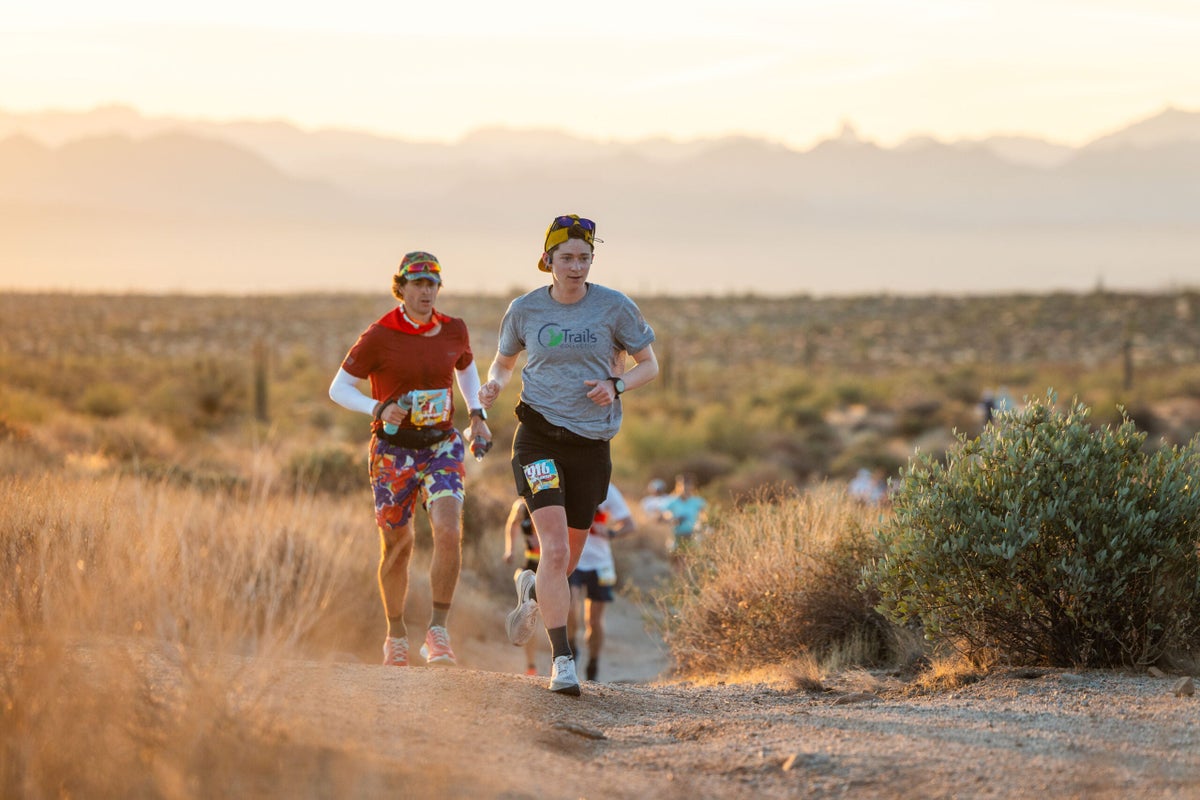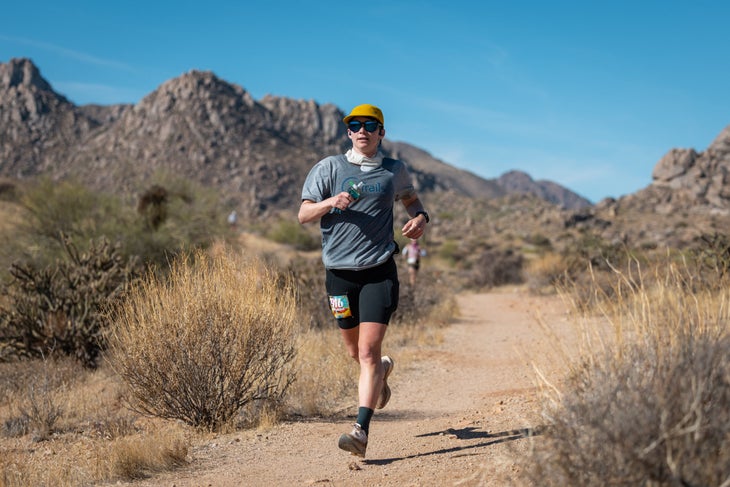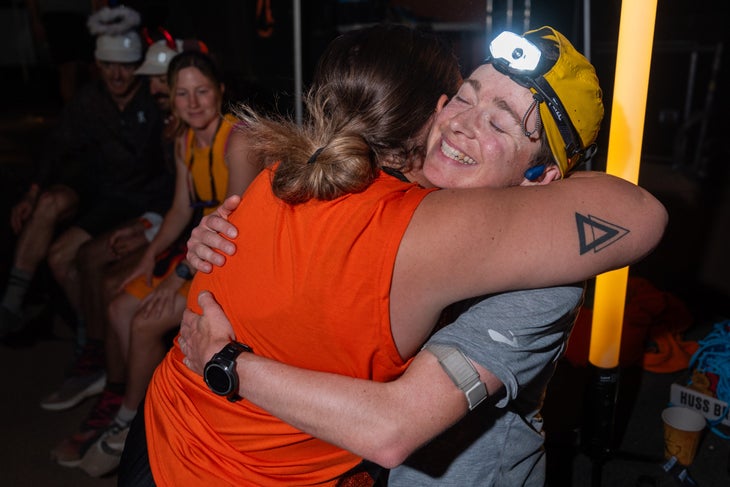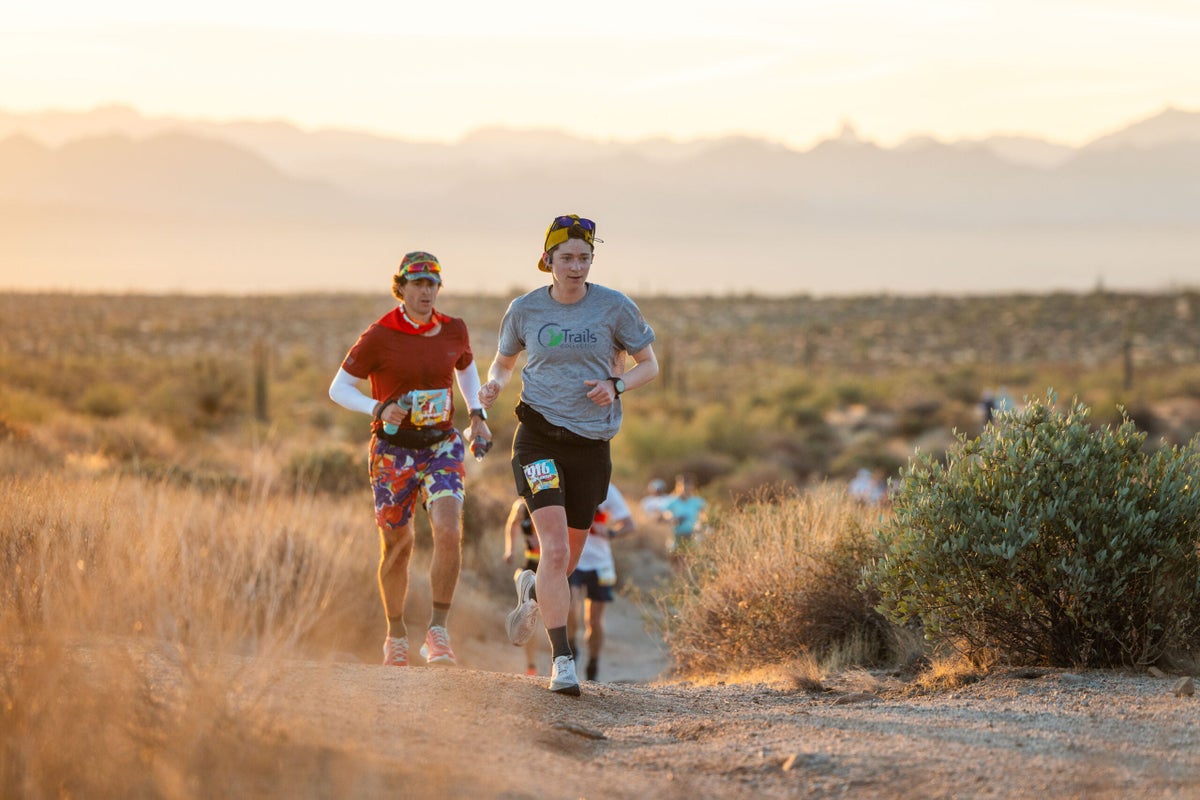
Editor’s Note: In anticipation of Riley Brady toeing the line as a top contender at the 2025 Western States 100 on June 28, we’re looking back on their meteoric rise.
Theoretically, Riley Brady didn’t need to kick into the finish line at the 2024 Javelina Jundred on October 26. The non-binary runner from Boulder, Colorado, had forged nearly a 20-minute gap over second-place woman Hannah Allgood during the last 99 and a half miles.
But they needed to kick it in nonetheless.
“I never feel like I have the win in the bag,” Brady said. “A race is not over ‘til it’s over. When people show up at a finish line and stop and walk across the line, I’m like, ‘You don’t know who’s back there! You don’t know who’s gonna sprint pass you!’ You have to Zack-Miller-finish this race. You should be sprinting as fast as you can across that line, and then you can collapse, or walk, or do whatever you want.”
And that’s exactly what Brady did. The glow of their headlamp bobbed through the darkness, rounded the turn into the iridescent tent city that makes up the Javelina headquarters, and zoomed down the seemingly never-ending straight away. Brady zipped across the finish line and in one fluid motion doubled over, hands precariously holding the upper half of their body up on their knees.
They stopped the clock in 14:19:01—the second fastest time ever in the women’s race on a historically hot day that saw the thermometer creep up to 100 degrees Fahrenheit.
It’s their third consecutive Javelina Jundred podium, second golden ticket into Western States, and first win at the Burning-Man-meets-Halloween-meets-ultrarunning rave in Fountain Hills, Arizona. But simply examining those three data points from the end of October in 2022, 2023, and now 2024 leaves out much of the story—including why you may not even know who this very legitimate contender at the 2025 Western States 100 even is.
Here’s how the 29-year-old bike mechanic torched the Javelina Jundred this fall.
1. A Liquid Diet
Heading into Javelina in October, there was no question to those that know them that Brady was fit. Scary fit. (This author understood this deeply first hand, having had the privilege of getting dropped by Brady many times on long runs and workouts over the past year.) The big question was: could their stomach hold it together enough to let their fitness shine?
Violent nausea and vomiting that reduced Brady to the fetal position on the side of the trail had been their downfall in longer races ever since earning a golden ticket with a second-place finish at Javelina in 2022, including at Western States itself in 2023, Black Canyon 100K and Javelina in 2023, and the Black Canyon, Canyons 100K (where they were also sick with a virus), and CCC 100K earlier this year.
“I’ve always thrown up in races, and it’s been an easy puke and rally,” Brady said. “But this vomiting was so violent I couldn’t hold my body up. It’s very different when it’s like you just take a gel and it doesn’t sit right so you just kind of throw up. You’re not collapsed on the ground.”
Enough was enough.
Brady enlisted the expertise of Vic Johnson, a registered dietitian who specializes in working with mountain athletes. Sweat testing revealed that Brady’s sweat and salt rates were both on the low end, and yet they had not been hydrating sufficiently during races. Johnson set Brady a minimum of drinking 500mL an hour.
“That’s one bottle an hour, which is quite low,” Brady said. “There have been times when I’ve definitely been drinking less than that, so he was like, ‘Once you start losing two to three percent of your body weight, that’s when we start to see those kinds of stomach issues come into play.”
Under Johnson’s guidance, Brady also started experimenting with more liquid calories and fewer gels, the texture of which immediately sent Brady’s gag reflexes on high alert. As the forecast called for temperatures reaching dangerously close to triple digits, that strategy proved especially prescient.

Brady did their best to drink 500 mL per hour on lap one of the five-lap course. The sun had yet to shine its wrath on the desert, and they probably fell a little short. But they were running well inside of themselves, just ahead of the lead women’s pack, and diligently downed a bottle of Skratch and Gatorade from aid stations on course, as well as a gel. (Aid stations also supplied Gu Roctane, but they didn’t have the Tea flavor and that’s the only flavor Brady doesn’t find repulsive.)
“The Gatorade tasted a little bit like a cleaning chemical, but it was good enough that I could get it down,” Brady said. “So I was like, ‘All right, I’m getting some calories, some salt from this.’”
Starting the third lap, Brady attempted to down a Precision Nutrition caffeine gel, which they had mixed into water in their soft flask just as they had done in training “because the texture is disgusting.” Their tried-and-true plan failed.
“I immediately threw up,” Brady said. “And I was like, ‘OK, I’m just going to cut this out.’”
Feeling like they could use some more calories on lap four, Brady tried taking one more gel, an SIS Beta Fuel—another tried-and-true staple. But the body rejected that, too.
“I cut those out, too,” Brady said. “I was like, ‘The liquid calories are working. I’m not going to mess with that.”
Brady estimates they took in 45 grams of carbs, or just under 200 calories, an hour for the duration of the race. While that’s more carbs than they’ve stomached in recent longer ultras, it’s about half as much as many high-carb proponents recommend. The bonk started catching up with them by lap five. But moving forward with some energy was better than curled up on the side of the trail with no energy at all.
2. Brady Math
A crown jewel of the Aravaipa Running race portfolio, the Javelina Jundred takes runners around the same 20-mile loop through the sandy washes of the desert five times. Each loop features a slight uphill over the first half to the highpoint near the foothills of the McDowell Mountains northeast of Phoenix before looping back down to the start for a total of about 1,580 feet of climbing and descent on each lap.
Five 20-mile loops may sound daunting. Not to Brady.
“I don’t think about the miles,” Brady said. “I’m like, ‘We’re running five laps.’ You just say ‘a lap,’ and it doesn’t sound that bad, you know?”
Compartmentalizing the 100-mile course into something as benign as a lap let Brady forget about the miles. In fact, they didn’t look at their watch once all day.
“I put the mileage out of my mind,” Brady said. “It’s really just one hard lap. The first one doesn’t count because it’s the first one. Second one, you’re probably still feeling pretty good, so it’s whatever. Third one is kind of hard, because it’s the heat of the day and it’s the third one. But then fourth one you get to pick up a pacer, so then you have a buddy. And fifth one, it’s the last lap, so you just gotta get one lap done.”
In fact, they just had to make it through half of one lap:
“It helps that it’s slightly uphill on the way out and then slightly downhill all the way back. So I just didn’t count the downhill. That’s easy running. So I just have to make it through half a lap.”
Sounds like Brady math, a mindset quite similar to that of another Brady legend.
“It’s not really how it plays out in reality,” Brady admitted. “But that’s how I like to think about it going into it.”
3. Ice, Ice Baby
Brady, who “hates” the cold, is a natural in scorching temperatures. But they didn’t take that aptitude for granted, making the extra effort to spend time in the sauna and hot tub at the rec center a couple of times a week, as well as running in the heat of the day on weekends during an usually hot fall in Boulder. They also applied a full heat protocol during the race, using pacer Leah Yingling’s special bandanas Lululemon made for the Further Project and dumping ice water on their head and down their shirt. It helped that Javelina supplied ice at every aid station.
It all paid off.
“To be honest, it felt hot but not crazy,” Brady said. “The only time I really felt like, ‘OK, I’m getting pretty warm here,’ was on the third lap during the heat of the day coming into Jackass.”
There, Brady took a few extra seconds to make sure their bottles were refilled, as well as to fully submerge in a kitty pool filled with ice water.
4. Road Running Super Shoes (Seriously)
Two weeks before the race, Brady had not as much as even ever tried on road super shoes. (They had worn trail super shoes, such as they are, to varying degrees of success.) That’s when they got their hands on a pair of Nike Vaporflys—a carbon-plated road running super shoe with next-to-no traction.
Brady took them out for a test drive on the Dirty Biz, a 15-mile, mostly buffed out trail and double-track loop just south of Boulder that Brady characterizes as more technical than the Javelina course. It was love at first run.
“I was like, ‘Wow. This fits my foot so perfectly. This feels so comfortable,” Brady said. “I felt super nimble.I just wasn’t thinking about my feet at all.”
For someone with a neuroma who’s relatively picky when it comes to shoes, this was a ringing endorsement.
“I didn’t feel like they were tippy,” Brady said. “I didn’t feel like I was going to roll an ankle.”
They admit the tread could be better, but that wasn’t going to make or break their shoe choice on a course as untechnical as Javelina. They had no regrets.
“I couldn’t have been more thrilled with them,” Brady said. “I got a few rocks in my shoes. The upper is pretty porous. But I don’t have any blisters. I didn’t think about my feet once throughout the day.”
Make no mistake, Brady says: this is not an advertisement for Nike. But they’ve never loved a shoe more.
5. Attitude of Gratitude
Brady’s shoe choice was a reflection of the freedom they’ve afforded themselves with a clear-headed attitude. Over the past several years, they’ve turned down modest sponsorship offers from shoe companies whose shoes were not the perfect fit.
“There have been some shoes that I just don’t see working for me in trail hundred milers. And that’s what I want to be running,” Brady said. “And so if the shoe is gonna irritate my foot, all the money in the world wouldn’t be worth it to me to have a shoe that doesn’t work.”
Running sponsorless has come with a price—Brady works as a bike mechanic, putting in three long, hard days a week on their feet and lugging heavy e-bikes and mountain bikes onto and off of bike stands. (They love that work so much, though, that they continued working overtime hours during the pandemic despite making less than they would have on unemployment.) And they don’t have any sponsor support to travel to races (although they have supportive parents, who attend all of Brady’s big races and pay for the rental house). While not having a sponsor might knock the confidence of some runners at Brady’s level, it doesn’t seem to phase them.
“I’m not somebody who feels like they need a sponsorship to feel secure in my sense of self,” Brady said. “I know that’s some people’s goal, but that’s not my goal at all. For a sponsorship to be worth it to me, it needs to support my ability to run.”
If Brady were to sign a sponsorship contract—and they are in talks with some companies—the deal would have to be big enough so they could quit their job as a bike mechanic. They don’t need time to train more: Brady puts in about 90 miles a week, going up to 100 on key weeks, with a few bike rides, strength training, heat protocol, and physical therapy slotted in there as well. But it’s a militant schedule that leaves little time for cooking, spending time with their two roommates and two cats, and no time for Brady pursuing their biggest hobby outside of running: welding. And that’s a passion they hope to turn into a career.
Brady carried this maturity to the race itself. After running alone off the front of the women’s race on lap one, Brady was caught by Allgood on the long climb out of headquarters on lap two. They just kept doing their own thing, and sure enough their agility on the 10-mile downhill back to the start line reestablished that gap. They didn’t see another competitor in the woman’s race for the rest of the day—minus everyone they lapped.

6. An A Team
Speaking of getting lapped, that’s the curse of doing well at this race. The faster you run, the more people you lap, and the more people you have to warn to get out of the way—as politely as you can, of course.
That’s where the power of the pacer came into play. Brady’s friend Chelsea Burns pulled them through lap four, and Yingling ran them home on lap five.
“It was really helpful to have Chelsea and Leah because they could tell people to move,” Brady said. “You’re passing so many people at that point, because the 100K is out on course, and then you’re catching all of the other people in the 100 miler because everybody’s just doing these same loops, and it gets really difficult when you’re tired to keep saying, ‘On your left! Excuse me! Coming through!’ And still sound kind about it. I definitely don’t want to be pissing people off out there, but also, I’m racing.”
Burns and Yingling also played the pivotal role of serving as Brady’s representative at aid stations, which while exceptionally well staffed were as chaotic as you would expect with hundreds of runners passing through every hour. (They were so chaotic, in fact, that at one point Brady and Burns got separated and Burns ran up the trail, thinking Brad had already left. They doubled back and found Brady just emerging from the aid station less than a handful of minutes later.) Brady’s pacers saved precious seconds by helping to acquire ice and fill bottles. Yingling, ever the consummate professional, provided just the stroke to the ego Brady needed on lap five to get them to the finish line and secure a golden ticket.
Secure a golden ticket they did. After failing to earn their way back into States last year, it’s a huge relief, Brady says. But you’ll see them on the golden ticket circuit again quite soon. They have some unfinished business at Black Canyons to attend to. And you’ll probably see them back at Javelina next year, too. But not with a bib pinned to their shirt.
“I really want to be top 10 at Western States,” Brady said. “I don’t want to have to go back [to Javelina]. I’ve done this race the last three years in a row. I want to get to experience some of the fun party aspects of Javelina. I have other friends who I think want to race it. I just really want to be on the crew and volunteer side of things. Aravaipa has been so great in terms of helping me get to this race, so I want to try and give back to Aravaipa in a small way.”
Because more than sponsorships or golden tickets, community is what attracted Brady to this sport as an undergraduate student at the University of Vermont, it’s largely what brought them out to Boulder (along with quality running and access to trans healthcare), and it’s what keeps them in the sport.
“This is probably gonna sound very cliché, and I really hate clichés, but I do feel so lucky to just have the best community around me,” Brady said. “Going into this race, I was reflecting and just felt so well supported. I’m very appreciative of David [Roche] for being a good coach, I have this great PT, and then just the best friends in Boulder.”
Roche, of course, won the men’s race.
Brady’s friend Rosie writes them a card before every race, and Javelina was no exception. And upon returning to Boulder after the race, Brady was greeted to a congratulatory sign on their bedroom door: “I’m fast as f***, boi!” And their two roommates took them out to a celebratory dinner.
“One of the reasons to do this sport is the community,” Brady said. “I’m just really, really grateful and feeling really well loved right now.”
🚗 Race Travel Made Easy
Traveling to your next 100-miler? Find the best deals on rental cars to get you to the starting line without breaking the budget.


Leave a Reply